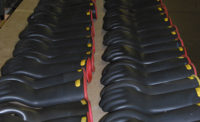Protecting hands from shock & arc flash
A new ASTM standard will broaden your choices

Despite the potential for serious injuries and fatalities, gloves were not considered when arc flash standards for clothing were first developed in the 1990s. For years electrical industry safety experts wanted the same type of rating on gloves as they had for clothing and face shields. After all, the hands are usually closer to the hazard than any other part of the body, says Hugh Hoagland, senior consultant, senior consultant, e-Hazard.
Keeping up with the standards
Progress has been made in the past 20 years. The ASTM F2675-13 Standard Test Method for Determining Arc Ratings of Hand Protective Products Developed and Used for Electrical Arc Flash Protection, published in 2013, determines the arc rating for hand protective products used when electrical arc flash is an assessed hazard.
Protector gloves use ASTM F696 Standard Specification for Leather Protectors for Rubber Insulating Gloves and Mittens. OSHA requires protector gloves be worn for arc flash protection and lists ASTM F696 as a standard. OSHA only allows rubber gloves to be worn alone in certain controlled situations and if there is no other option. Protector gloves have two primary purposes:
- Mechanical protection for the rubber insulating glove worn underneath.
- Arc flash protection of the rubber and hands.
When you have a shock and an arc flash hazard, Hoagland recommends protector gloves over rubber insulating gloves. The only standard for protector gloves is for leather gloves meeting ASTM F696.
According to OSHA and ASTM F496 Standard for In-Service Care of Insulating Gloves and Sleeves, if you use rubber insulating gloves without protectors, they must be tested after use. Even a small nick in a rubber glove can fail and allow fatal shock. Hoagland says protector gloves should be removed only when unusually high finger dexterity is needed, and processes where leather cannot be used, such as pharma and food processing.
Coming soon
ASTM has a proposed standard nearing completion to allow multi-material arc rated gloves to be used over leather gloves. These gloves get rated for cut and puncture and arc flash, unlike leather which has no rating required. New gloves with these characteristics can also be used for cut protection and safely operate electrical equipment when there is no shock hazard requiring rubber gloves.
The standard is proposed to be titled “Standard Specification for Leather and other Material Protectors for Rubber Insulating Gloves and Mittens.”
According to Hoagland, the standard will define performance-based criteria to meet or exceed leather in practice and testing. Cut, puncture, arc flash performance, abrasion and chemical resistance can be determined using the test methods and levels defined in ANSI/ISEA hand protection standard 105.
Arc-rated gloves
For now, arc rated gloves without rubber insulating gloves can be used in these applications, according to Hoagland:
- “Heavy duty leather gloves” for arc flash protection (NFPA 70E Standard for Electrical Safety in the Workplace requires these for jobs without shock hazards).
- To replace “heavy duty leather gloves” when they are inadequate for other multiple threats.
- NFPA 70E 2015 states: “The combination of rubber insulating gloves with leather protectors satisfies the arc flash protection requirement.” “Arc rated gloves” for the non-shock hazard tasks have arc flash potential have been on the market for several years now.
Looking for a reprint of this article?
From high-res PDFs to custom plaques, order your copy today!





